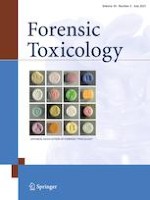Erschienen in:

11.05.2021 | Original Article
Effects of putrefaction on the quantitative analyses of diphenhydramine in blood and tissues: model experiments by the routine matrix-matched calibration method and standard addition method with different internal standards
verfasst von:
Keiko Kudo, Kanju Saka, Brian Waters, Kenji Hara, Aya Matsusue, Masayuki Kashiwagi, Shin-ichi Kubo
Erschienen in:
Forensic Toxicology
|
Ausgabe 2/2021
Einloggen, um Zugang zu erhalten
Abstract
Purpose
The purpose of this study was to elucidate the effect of putrefaction on the quantitative analyses of diphenhydramine in blood and tissues by the routine matrix-matched calibration (MMC) method and the standard addition (SA) method for comparison.
Methods
Putrefied samples were prepared by leaving pig blood, liver and muscle at room temperature. Toxic amounts of diphenhydramine and six internal standards (ISs) having different similarities were added to the prepared samples, and the drug was extracted with a liquid-liquid extraction method. The concentrations of diphenhydramine were determined by liquid chromatography–tandem mass spectrometry. The accuracies and precisions of the obtained quantitative values were compared in each quantification method. The results were also verified using human blood and tissues obtained at the time of autopsy.
Results
In the MMC method, the deuterium-labeled IS showed good accuracies and precisions for putrefied samples. On the other hand, the concentrations of diphenhydramine using some non-isotopic ISs were found to deviate significantly from the true value.
Conclusions
The obtained results showed that the MMC method using fresh blood calibration curve with isotope-labeled IS could accurately measure drug concentrations in putrefied blood and tissues. If the isotope-labeled compound is not available, the quantification by the MMC method seems effective using several ISs with high similarity. This kind of study on the effects of putrefaction on forensic analyses has not been reported to our knowledge.











